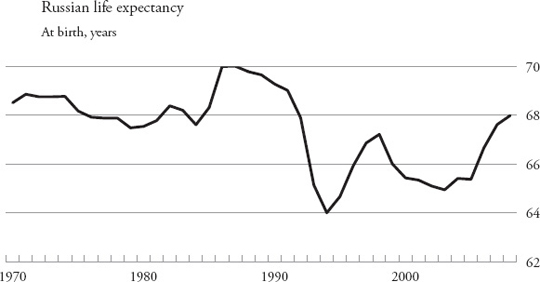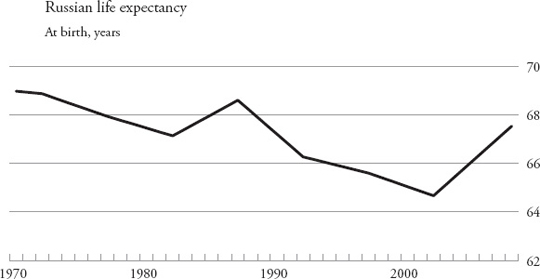The Body Economic (9 page)
Authors: David Stuckler Sanjay Basu

F
IGURE 2.4
Russian Life Expectancy: Real Data, Our Graph
44
The attacks next turned into outright manipulation. Two weeks after our article was published, The
Economist
magazine, which backed Shock Therapy, wrote an opinion article dismissing the health effects of rapid privatization, concluding that “mistakes were made but Russia's tragedy was that reform came too slowly, not too fast.” The editors of the magazine manipulated the mortality crisis data in a manner that made it look like the deaths had disappeared. By averaging the data over five yearsâand selectively choosing some survey years rather than othersâthey smoothed the death rate curve in 1990s Russia. This made the dramatic increase in mortality look like a steady declineâan easy way to “lie with statistics.” If our university students had committed that kind of statistical manipulation on their term papers, they would be sent to the Dean. While Stalin doomed millions of people with the stroke of a pen in the 1930s, The
Economist
, it seemed, managed to bring millions of the dead back to life with a click of a computer mouse.
46
What got lost in all the desperate attempts to deny the data was one of the most important findings from the research: how to prevent economic shocks from impacting people's health.
47
Today, two decades after Russia began its transition to capitalism, the health of Russian men is still worse than it was before reforms began in 1991. Over-all
life expectancy for men and women was sixty-eight years in 1991; in 2012 it was sixty-six years. The death of millions of Russian men continues to haunt the nation. Even the mighty Russian military has now faltered, unable to find sufficient healthy recruits to replenish its ranks.
49

F
IGURE 2.5
Russian Life Expectancy: Our Graph, as Re-engineered by The
Economist
48
While men began dying in greater numbers following Shock Therapy, the whole nation suffered. Those left behind now feel the brunt of the death of a breadwinner. In Russia, it's not just the elderly but a generation of young women who now face hardship. Russia's women face the disheartening prospect of having to shoulder the burden of debt and house hold expenditures alone, after their husbands died too young.
Although Russia has now concluded its painful transition to capitalism, the lasting effects of this journey continue to impact health. After the shocks of privatization, Russia's crumbling system of workplace-associated medical clinics was no longer able to control infectious diseases. Once thought to be a disease of the past in Russia, tuberculosis has returned with a vengeance, with a rise starting in 1992. Together with sub-Saharan Africa, the former Soviet bloc is now one of only two regions in the world that are losing the fight against tuberculosis. The failures to curb tuberculosis are so grave in Russia that it has become the epicenter of new, mutant variants that resist nearly all antibiotics. This advance of “multi-drug-resistant” tuberculosis poses serious threats worldwide.
50
The massive hit to public health in Russia is particularly tragic when it becomes clear that Shock Therapy didn't achieve its other stated aims. Perhaps the 10 million deaths would be easier to stomach if the rapid transition to a market economy had improved the standard of living and health for Russians over time. But instead, Russia's privatization programs served largely to create the country's own version of “the 1 percent”âoligarchs with vast wealth and power.
The experiences of other communist countries show that Russia could have traveled down a gradualist path to capitalism. In China, for example, the Communist Party rejected calls for Shock Therapy during the 1980s and 1990s, instead privatizing gradually while slowly relaxing the state's grip on the economy. China's growth rates have been in the double digits, year after year, even amid the recession that started in 2007. And its population's health has benefited from China's model of economic growth; China now boasts health statistics that rival some Western nations. While China's life expectancy for both men and women in 1985 was sixty-seven, it is now seventy-three.
51
Russia wasn't the only victim of Shock Therapy. Through a series of debt crises in the 1980s and 1990s, the International Monetary Fund and World Bank pushed radical economic policies onto countries in Latin America, sub-Saharan Africa, and Asia. The vast nation of Indonesia was the next unfortunate guinea pig for the Shock Therapists, who stepped in to advise the country about how to respond to the threats to its economy and health wrought by the East Asian Financial Crisis of the 1990s.
FROM MIRACLE TO MIRAGE
Kanya was just sixteen when she started coughing up blood. It was 2001, and she was one of hundreds of farmers' daughters around Kanchanaburi, an area of Western Thailand, who were experiencing strange symptoms: rashes, weight loss, and chest infections including pneumonia and tuberculosis.
At the time, Sanjay was helping the Thai government's “mobile clinics”âpickup trucks and cargo vans that the Ministry of Health in Thailand had converted into roaming medical clinics. The backs of the trucks were stocked with drugs and ban dages, and the driversâtwo nurses and a local doctorâwould drive between villages near the Thai-Burmese border, stopping at each house along the way to offer free basic healthcare services to farmers and their families who otherwise couldn't afford it.
The farmers were suffering from the worst financial crisis since Russia's debacle. Since 1997, Thailand and its neighboring countries had experienced a dramatic rise in poverty after a real estate bubble burst, plunging East Asia into a deep recession. The International Monetary Fund, an international bank that was the “lender of last resort,” had offered bailouts, but on the condition that countries implement massive austerity on health and social services. The funding cuts could not have come at a worse time. Hundreds of thousands of farmers in rural areas around Kanchanaburi had lost their ability to sell goods on the common marketplace, as fluctuations in the prices of rice and vegetables had left
them on the losing end of trade deals. Austerity meant that there was no buffer, and the farmers struggled to make enough money to avoid starvation.
1
Kanya told the clinic's director what had happened. After the crisis hit, she had been recruited by “city men” who said that she could get a good job in Bangkokâwaitressing at restaurants or manufacturing clothing in factories. With her earnings, she could send money back home to her family who couldn't afford food or medicine. But rather than being brought to riverside restaurants or factories to work, she was taken to one of Bangkok's red-light districts. There, a German tourist repeatedly raped her.
After hearing her story, the mobile-clinic doctor tested Kanya and others for HIV. Like all of the young Kanchanaburi women who presented with unexpected weight loss, rashes, pneumonias, or tuberculosis, Kanya tested HIV positive. Left undiagnosed for several years, HIV had weakened her immune system, leaving her susceptible to tuberculosis.
Kanya had managed to escape Bangkok to her family, but by that point her family could do little to help her. She had been diagnosed far too late. Her immune system weakened, she died from complications of tuberculosis.
Kanya was not alone. In 1998, Thailand's death rate from infectious diseases began to rise. In the next five years, there were more than 50,000 excess deaths from pneumonias, tuberculosis, and HIVâdeaths that followed a large dose of austerity.
Kanya's story begins with the financial boom that started in the 1980s. International investors were thrilled with the “emerging markets” in East Asia. Nearly half of the world's foreign investment flowed there. Investors reaped windfall profits. Thailand and many of its neighboring countries like Indonesia and Malaysia were experiencing remarkable economic growth at rates near or above 5 percent each year. As real estate boomed, employment rose, and poverty levels dropped. For the first time, many Asian children (including girls) not only got the opportunity to go to school, but started achieving math and science exam scores higher than children in the West.
2
The World Bank labeled several countries in the region “Asian Tigers.” The Bank called it the “Asian Miracle,” a “model” for the rest of the world to follow.
3
If this seemed too good to be true, that's because it probably was. Before the crisis began, the international finance community had been working suspiciously
hard to preserve the image of the Asian Miracle. An exposé in The
Wall Street Journal
reported that the World Bank, at the insistence of the Indonesian government, had “softened reports on Indonesia's economy, reports that helped the government win better ratings and draw in capital.” Dennis de Tray, an economist who ran the 150-person World Bank mission in Indonesia, admitted that “in every country that we operate in there is a trade-off between, shall we say, being pure and helping people”âessentially noting that the World Bank thought it was helping people by promoting the Asian Miracle.
4
The inflated reports did not fool all observers; some saw through the hype and recognized that a full-blown crisis was brewing. In 1994, the oft-prescient Paul Krugman warned of the “myth of the Asian miracle.” He noted that Asia's rapid development was powered by extraordinary boosts in foreign capital rather than by investments that were enhancing technology or more efficiency at work, a tell-tale sign of an economic bubble. A glut in real estate had developed, and, by 1996, $20 billion of residential property remained unsold. Many buildings stood empty.
5
By early 1997, investors had become jittery about whether these real estate deals were simply inflating a housing bubble. Never missing an opportunity, the investor George Soros and his Quantum Fund placed bets that East Asia's currencies were overvalued and would fall in price. His move stoked feelings of panic. Throughout the region, markets and currencies crashed. In 1997 and 1998, the Thai baht and the Indonesian rupiah lost, respectively, 75 percent and 80 percent of their value. As the dominoes fell, the entire region was soon engulfed in the financial panic of devalued currencies. All the capital that had been pouring into the Asian economies soon started to flood out. Foreign investors withdrew $12 billion of investments from real estate and other industries, further reducing the value of the region's currencies. By mid-January 1998, the currencies of all “emerging” market economies in Southeast Asia had lost half of their pre-crisis value.
6
East Asians now experienced an economic catastrophe analogous to the Great Depression in the US. The price of food doubled, with rice and other staple food prices increasing the most because the currencies in these countries had become worth less. To make matters worse, an El Niño weather cycle contributed to a massive drought in October 1997, leading to rice and cereal shortages and further increases in the prices of basic foods. The poverty rate in Indonesia jumped from 15 percent to 33 percent in just over a year.
7
That is why Kanya's parents had sent her to the “city men” to help support the family.
Faced with starvation, people across East Asia took to the streets in protest. In May 1998, riots broke out in Jakarta, ultimately leading to the fall of President Suharto's dictatorial regime. The violence terrorized the nation, as communities descended into chaos. Its victims were often women: at least 168 rapes were documented. A Chinese ethnic minority, seen as the privileged business class, were also targets of mob attacks.
8